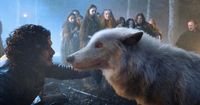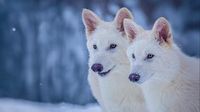In a groundbreaking development that seems to leap straight out of a fantasy novel, Colossal Biosciences has announced the successful revival of the dire wolf, an animal that has been extinct for approximately 13,000 years. This remarkable feat, which the company dubs the "world's first successfully de-extincted animal," has sparked both excitement and skepticism among scientists and fans alike.
The dire wolf, a creature made famous by its appearance in the HBO series "Game of Thrones," has long captured the imaginations of viewers and readers. Now, thanks to advancements in genetic engineering, this ancient species is making a comeback. Colossal Biosciences has introduced three new dire wolf pups, named Romulus, Remus, and Khaleesi, who were born in the fall and winter of 2024 and 2025 respectively. These pups are not mere replicas; they are the result of a meticulous process that involved gene editing and cloning.
Colossal Biosciences utilized ancient DNA from a 13,000-year-old dire wolf tooth and a 72,000-year-old skull to reconstruct the genome of the dire wolf. By using CRISPR technology, scientists modified the DNA of existing animals—specifically gray wolves—to replicate the traits of the extinct dire wolf. The pups were carried to term by domestic dog surrogates, and they now exhibit physical characteristics similar to their ancient ancestors, including long white fur and muscular jaws.
According to Ben Lamm, co-founder and CEO of Colossal, this achievement represents a significant milestone in the field of de-extinction. "We produced something that is magnificent and science fiction at its finest," Lamm stated in a recent announcement. The dire wolf pups currently reside in a secure, undisclosed location that spans over 2,000 acres, where they are monitored by a team of animal care staff and advanced surveillance systems.
While the revival of the dire wolf is undoubtedly a scientific marvel, it raises important questions about the implications of de-extinction. Critics argue that simply recreating an extinct species does not mean it can fulfill the ecological roles it once held. Vincent Lynch, a biologist at the University at Buffalo, cautioned that although the pups may resemble dire wolves, they cannot replicate the ecological functions their ancestors performed in the wild. "All you can do now is make something look superficially like something else," Lynch remarked.
The ethical considerations surrounding de-extinction are also a focal point of debate. Some scientists worry that such efforts may divert attention and resources from preserving existing endangered species. However, Colossal insists that their work is aimed at both reviving lost species and enhancing conservation efforts for those that still exist. Dr. Christopher Mason, a scientific advisor for Colossal, emphasized the potential benefits of their technology for conservation, stating that the same techniques used to create the dire wolf could help save endangered wolves and other mammals.
Meanwhile, the involvement of George R.R. Martin, the author of "A Song of Ice and Fire," has added another layer of intrigue to the story. Martin is not only an investor in Colossal but also serves as an advisor. His participation has drawn mixed reactions from fans, many of whom are frustrated that he is involved in such a high-profile project while they eagerly await the next installment of his book series, "The Winds of Winter." One fan expressed exasperation on Reddit, saying, "Anything but writing a new damn chapter." Another lamented, "He can't focus long enough to pay them any mind! I am so over him!"
Despite the backlash, Martin remains optimistic about the project. In a recent statement, he noted, "Many people view dire wolves as mythical creatures that only exist in a fantasy world, but in reality, they have a rich history of contributing to the American ecosystem." He added that while he enjoys writing about magic, Colossal has created real magic by bringing these majestic beasts back to our world.
As the world watches this ambitious experiment unfold, it is clear that the revival of the dire wolf is more than just a scientific curiosity; it is a reflection of humanity's evolving relationship with nature and the lengths to which we will go to correct past mistakes. Whether this endeavor will ultimately prove beneficial for the environment remains to be seen, but for now, the dire wolf is back, and it has captured the attention of both the scientific community and the public.
In conclusion, the return of the dire wolf serves as a reminder of our ability to manipulate nature through science, but it also prompts us to consider the responsibilities that come with such power. As we step into this new era of de-extinction, the hope is that we can learn from the past and use our knowledge to protect and preserve the biodiversity that remains.








